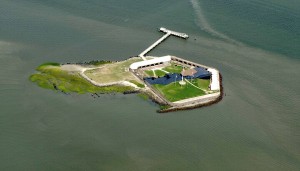Good morning, Whitewater.
Sunday brings a high of sixty-seven, and a one-fifth chance of afternoon showers. Sunrise is 6:16 and sunset 7:34, for 13h 17m 07s. The moon is a waning crescent with 46.1% of its visible disk illuminated.
The latest FW poll asked readers whether they thought Godzilla would be a good tourism ambassador for Japan. Over two-thirds of respondents thought that he would.
On this day in 1861, Confederate artillery opens fire on Fort Sumter, beginning fighting during the Civil War:
On Friday, April 12, 1861, at 4:30 a.m., Confederate batteries opened fire, firing for 34 straight hours, on the fort. Edmund Ruffin, noted Virginian agronomist and secessionist, claimed that he fired the first shot on Fort Sumter. His story has been widely believed, but Lieutenant Henry S. Farley, commanding a battery of two 10 inch siege mortars on James Island fired the first shot at 4:30 A.M. (Detzer 2001, pp. 269–71). No attempt was made to return the fire for more than two hours. The fort’s supply of ammunition was not suited for the task; also, there were no fuses for their explosive shells, which means that they could not explode. Only solid iron balls could be used against the Rebel batteries. At about 7:00 A.M., Captain Abner Doubleday, the fort’s second in command, was given the honor of firing the Union’s first shot, in defense of the fort. He missed, in part because Major Anderson did not use the guns mounted on the highest tier, the barbette tier (where the guns could engage the confederate batteries better), where the gunners would be more exposed to Confederate fire. The firing continued all day. The Union fired slowly to conserve ammunition. At night the fire from the fort stopped, but the Confederates still lobbed an occasional shell into Sumter. On Saturday, April 13, the fort was surrendered and evacuated. During the attack, the Union colors fell. Lt. Norman J. Hall risked life and limb to put them back up, burning off his eyebrows permanently. A Confederate soldier bled to death having been wounded by a misfiring cannon. One Union soldier died and another was mortally wounded during the 47th shot of a 100 shot salute, allowed by the Confederacy. Afterwards the salute was shortened to 50 shots. Accounts, such as in the famous diary of Mary Chesnut, describe Charleston residents along what is now known as The Battery, sitting on balconies and drinking salutes to the start of the hostilities.
The Fort Sumter Flag became a popular patriotic symbol after Major Anderson returned North with it. The flag is still displayed in the fort’s museum. A supply ship Star of the West took all the garrison members to New York City. There they were welcomed and honored with a parade on Broadway.

